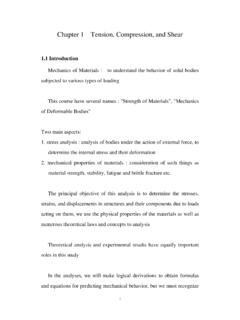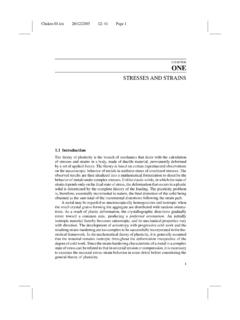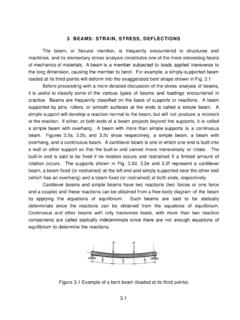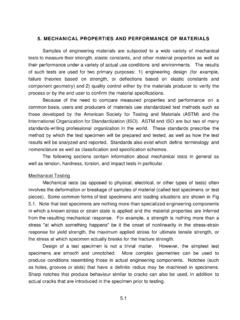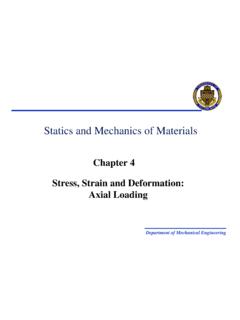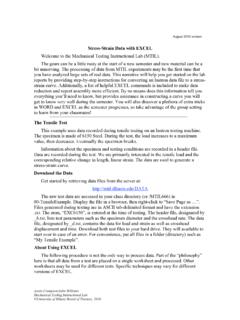Transcription of Chapter 7 Analysis of Stresses and Strains - 首頁
1 1 Chapter 7 Analysis of Stresses and Strains Introduction axial load " = P / A torsional load in circular shaft $ = T ! / Ip bending moment and shear force in beam " = M y / I $ = V Q / I b in this Chapter , we want to find the normal and shear Stresses acting on any inclined section for uniaxial load and pure shear, this relation are shown in chapters 2 and 3, now we want to derive the transformation relationships that give the stress components for any orientation this is referred as stress transformation when an element is rotated from one orientation to another.
2 The Stresses acting on the faces of the element are different but they still represent the same state of stress , namely, the stress at the point under consideration Plane stress consider the infinitesimal element with its edges parallel to x, y, and z axes if only the x and y faces of the element are subjected to Stresses , it is called plane stress , it can be shown as a two dimension stress element 2equal normal Stresses act on opposite faces, shear stress $ has two subscripts, the first denotes the face on which the stress acts, and the second gives the direction of that face $xy : acts on x face directed to y axis $yx : acts on y face directed to x axis sign convention : acts on !
3 Face and directed to ! axis as + as discussed in Chapter 1, $xy = $yx consider an element located at the same point and whose faces are perpendicular to x1, y1 and z1 axes, in which z1 axis coincides with the z axis, and x1 and y1 axes are rotated counterclockwise through an angle x and y axes, the normal and shear Stresses acting on this new element are denoted "x1, "y1, $x1y1 and $y1x1 also $x1y1 = $y1x1 the Stresses acting on the rotated x1y1 element can be expressed in terms of stress on the xy element by using equation of static equilibrium choose a wedge-shaped element force equilibrium in x1-direction "x A0 sec - "x A0 cos - $xy A0 sin 1 - "y A0 tan sin - $yx A0 tan con = 0 force equilibrium in y1-direction $x1y1 A0 sec + "x A0 sin - $xy A0 cos 3 - "y A0 tan cos
4 + $yx A0 tan sin = 0 with $xy = $yx it is obtained "x1 = "x cos2 + "y sin2 + 2 $xy sin cos $x1y1 = - ("x - "y) sin cos + $xy (cos2 - sin2 ) for = 01 "x1 = "x $x1y1 = $xy for = 901 "x1 = "y $x1y1 = - $xy from trigonometric identities 1 1 cos2 = C (1 + cos 2 ) sin2 = C (1 - cos 2 ) 2 2 1 sin cos = C sin 2 2 the above equations can be expressed in a more convenient form "x + "y "x - "y "x1 = CCC + CCC cos 2 + $xy sin 2 2 2 "x - "y $x1y1 = - CCC sin 2 + $xy cos 2 2 this is the transformation equations for plane stress substituting + 901 for in "x1 equation "x + "y "x - "y "y1 = CCC - CCC cos 2 - $xy sin 2 2
5 2 also we obtain the following equation for plane stress 4 "x1 + "y1 = "x + "y the sum of the normal Stresses actin on perpendicular faces for aplane stress element is constant, independent of "x1 and $x1y1 versus the angle of rotation can be plotted as for uniaxial stress case, "y = 0, $xy = 0 "x1 = "x cos2 = "x (1 + cos 2 ) / 2 $x1y1 = - "x sin cos = - "x sin 2 / 2 for pure shear stress case, "x = "y = 0 "x1 = 2 $xy sin cos = $xy sin 2 $x1y1 = $xy (cos2 - sin2 )
6 = $xy cos 2 same as derived in previous chapters for biaxial stress case, $xy = 0 "x + "y "x - "y "x1 = CCC + CCC cos 2 2 2 "x - "y $x1y1 = - CCC sin 2 2 Example 7-1 "x = 110 MPa "y = 40 MPa $xy = $yx = 28 MPa determine the Stresses for = 451 5 "x + "y "x - "y CCC = 75 MPa CCC = 35 MPa 2 2 sin 2 = sin 901 = 1 cos 2 = cos 901 = 0 "x + "y "x - "y "x1 = CCC + CCC cos 2 + $xy sin 2 2 2
7 = 75 + 35 x 0 + 28 x 1 = 103 MPa "x - "y $x1y1 = - CCC sin 2 + $xy cos 2 2 = - 35 x 1 + 28 x 0 = - 35 MPa "x1 + "y1 = "x + "y "y1 = "x + "y - "x1 = 110 + 40 - 103 = 47 MPa Example 7-2 "x = - 46 MPa "y = 12 MPa $xy = $yx = - 19 MPa determine the Stresses for = - 151 "x + "y "x - "y CCC = - 17 MPa CCC = - 29 MPa 2 2 sin 2 = sin (- 301) = - cos 2 = cos (- 301) = "x + "y "x - "y "x1 = CCC + CCC cos 2 + $xy sin 2 2 2 = - 17 + (- 29) + (- 19) ( ) = - MPa 6 "x - "y $x1y1 = - CCC sin 2 + $xy cos 2 2 = - (- 29) ( ) + (- 19) = - 31 MPa "x1 + "y1 = "x + "y "y1 = "x1 + "y - "x = - 46 + 12 - (- )
8 = - MPa Principal Stresses and Maximum Shear Stresses "x1 and $x1y1 vary continuously as the element is rotated through the angle for design purpose, the largest positive and negative Stresses are usually needed, the maximum and minimum normal Stresses are called the principal Stresses consider the stress transformation equation "x + "y "x - "y "x1 = CCC + CCC cos 2 + $xy sin 2 2 2 to find the maximum normal stress , we may set d "x1 / d = 0 d "x1 CC = - ("x - "y) sin 2 + 2 $xy cos 2 = 0 d 2 $xy we get tan 2 p = CCC "x - "y p defines the orientation of the principal plane, two values of 2 p from 0 ~ 3601 and differ by 1801 7 p has two values differ by 901, we conclude that the principal Stresses occur on mutually perpendicular plane also ("x - "y)
9 / 2 cos 2 p = CCCCC R $xy sin 2 p = C R "x - "y 2 2 where R = [(CCC) + $xy2] 2 substitute cos 2 p and sin 2 p into the expression of "x1 "x + "y "x - "y 2 2 "1 = ("x1)max = CCC + [(CCC) + $xy2 ] 2 2 and the smaller principal stress denoted by "2 is obtained "1 + "2 = "x + "y "x + "y "x - "y 2 2 "2 = ("x1)min = CCC - [(CCC) + $xy2] 2 2 the principal Stresses can be written as "x + "y "x - "y 2 2 "1,2 = CCC !
10 [ (CCC) + $xy2] 2 2 + sign gives the larger principal stress - sign gives the smaller principal stress p1 and p2 can be determined, but we cannot tell from the equation which angle is p1 and which is p2 an important characteristic concerning the principal plane : the shear is 8zero on the principal plane "x - "y $x1y1 = - CCC sin 2 + $xy cos 2 2 substitute 2 p into this equation, we can get $x1y1 = 0 for uniaxial and biaxial stress states, $xy = 0 tan 2 p = 0

